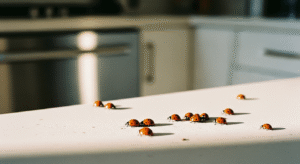Ants vs Other Insects: Unique Symbiotic Bonds
In the complex world of insects, ants have forged myriad relationships ranging from mutually beneficial partnerships to exploitative arrangements that sometimes overlap with ant-control strategies. This article explores the intricate symbiotic bonds ants share with various insect partners, examining how these associations affect their behavior, survival strategies, and ecological roles. Homeowners and businesses dealing with ant-control infestations may benefit not only from understanding these relationships but also by seeking expert pest control services.
Understanding Symbiosis in Ant Colonies and Insect Interactions
Ant colonies are known for their cooperative behavior and also engage in varied relationships with other insects. These interactions—sharing food, protection, and even nest space—range from mutually beneficial alliances to arrangements where one party exploits the other.
Defining Different Forms of Symbiotic Relationships
“Symbiosis” encompasses mutualism, commensalism, and parasitism. In mutualism, both ant colonies and their insect partners gain benefits such as nutrient exchange or predator defense. Commensalism, however, allows one species to benefit without affecting the other, while parasitism involves exploitation for survival. These definitions help categorize observed interactions.
The Spectrum of Ant and Insect Partnerships
Ant-insect partnerships vary widely. Some alliances improve both species’ survival—for instance, ants farming aphids receive sugary secretions while aphids gain protection. In contrast, parasitic relationships can weaken ant colonies when insects exploit their resources. This variation underscores the dynamic nature of ant symbiosis.
How Ants Establish and Maintain Their Symbiotic Relationships
Ants use pheromone signals and physical contact to initiate and sustain interactions. Chemical secretions help identify cooperative partners while tactile cues coordinate defense and foraging. This efficient communication supports stable, beneficial partnerships within the colony.
Comparing Ant Symbiosis With Other Insect Alliances
While ant symbioses are highly evolved due to their social structure, other insects also form temporary alliances using strategies like chemical mimicry. Ant alliances, however, tend to be more stable and long-term because of their organized colony structure and collective decision-making.
Mutual Benefits in Ant and Insect Cooperations
Mutualistic relationships are central to many ant interactions, as they combine defense strategies and resource sharing to enhance overall fitness.
Aphids and Ants a Classic Case of Reciprocal Aid
A classic example is the mutualism between ants and aphids: ants protect aphids from predators while harvesting the honeydew they excrete. This relationship boosts aphid survival and provides ants with a steady energy source; studies indicate that ant attendance can significantly enhance aphid reproduction.
Lycaenid Butterflies and Ants Shared Life Cycles
Lycaenid butterflies benefit from ant protection during their larval stage. In exchange for shelter and defense, the larvae secrete nutrient-rich substances. This mutual aid not only increases larval survival but also reinforces chemical communication between species.
Ants Cultivating Fungi a Farming Symbiosis Involving Insects
Leafcutter ants cultivate fungi by collecting plant material that acts as a substrate for growth. This advanced mutualism provides a renewable food source for the ants while the fungi secrete enzymes to break down nutrients, supporting the colony’s diet.
Protection Services Ants Offer Their Insect Allies
Protection is a key benefit in many ant partnerships. By defending their territory aggressively, ants help protect symbiotic partners such as scale insects and certain beetles, reducing predation risks and promoting mutual survival.
Nutritional Gains for Ants From Their Symbiotic Relationships
Ants often supplement their diets with nutrients obtained from symbiotic partners, such as sugars from honeydew or proteins from regurgitations. These nutritional contributions are vital during times of resource scarcity and help sustain colony health.
Commensalism One-Sided Benefits in Ant and Insect Cohabitation
Not every ant-insect interaction is mutually beneficial. In some cases, one species benefits without significantly affecting the other, illustrating commensalism.
Insects Living Innocuously Within Ant Nests
Some insects take refuge in ant nests, benefiting from the stable microenvironment and available food waste without disturbing colony functions.
Scavenging Insects Thriving Alongside Ant Colonies
Scavengers exploit waste from ant colonies for nutritional gain. Their presence, while not directly cooperative, highlights how ant nests support broader biodiversity.
How Ants Tolerate Non-Harmful Insect Residents
Ants often tolerate harmless cohabitants due to chemical camouflage or because these insects pose no threat. This tolerance allows for peaceful coexistence, with commensal species gaining consistent shelter and food.
Examples of Ants and Their Commensal Insect Relationships
Examples include springtails and mites that reside in ant nests. These organisms benefit from the ambient warmth and nutrient leftovers while remaining largely unnoticed by the ants.
Exploitation in Ant and Insect Symbiotic Relationships
Exploitation occurs when one organism benefits at the expense of another. In some ant colonies, parasitic relationships evolve, blurring lines between mutualism and exploitation.
Parasitic Insects Targeting Ant Colonies
Certain parasitic insects, such as the Phorid fly, lay eggs in ant colonies, eventually harming the host ants. Such interactions reduce colony productivity and increase mortality, diverging sharply from mutualistic benefits.
Ants as Unwitting Hosts in Certain Symbiotic Bonds
Ants can unwittingly host parasites that manipulate their behavior for the parasite’s benefit. This exploitation diminishes colony efficiency and disrupts normal functioning, with some infestations reportedly reducing foraging efficiency.
Cuckoo Ants Deceiving Host Ant Societies
Cuckoo ants infiltrate colonies by mimicking chemical signals, deceiving hosts to exploit resources. This deception allows the parasitic species to reproduce secretly, further draining the hostcolony’s reserves.
The Fine Line Between Mutualism and Parasitism in Ant Interactions
Environmental changes or shifts in population dynamics can tip a relationship from mutualism to parasitism. This delicate balance underscores the evolutionary fluidity of these interactions and the importance of context in determining benefit or harm.
Symbiotic Partnerships Between Ants and Other Insects
Ants possess unique social and chemical traits that distinguish their symbiotic relationships. These features are crucial for research and effective pest management.
The Role of Ant Social Structure in Complex Symbioses
Ant colonies function as superorganisms with intricate communication networks and division of labor. This organized structure supports stable and long-lasting symbiotic bonds through coordinated defense, foraging, and reproduction.
Chemical Communication Facilitating Ant and Insect Partnerships
Pheromones play a pivotal role in ant communications, ensuring that both mutualistic and commensal partners are recognized. This chemical signaling enables precise resource sharing and coordination of activities.
Longevity and Stability of Ant Symbiotic Relationships
Due to their resilient colony structure and efficient resource management, ant-insect symbioses are often more enduring than partnerships formed by solitary insects. This stability enhances overall reproductive success for both parties.
Contrasting Ant Cooperation With Solitary Insect Behaviors
Unlike transient interactions seen in solitary insects, ants maintain prolonged, stable relationships thanks to their organized colony life, highlighting the advantages of collective living and coordinated defense.
Unique Defensive Alliances Formed by Ants and Other Insects
Some ants form distinctive alliances to deter predators. For example, certain beetles collaborate with ant colonies by performing tasks like cleaning debris, underscoring the tactical benefits of such symbioses.
Ecological Significance of Ants and Their Symbiotic Relationships
The relationships between ants and other insects have far-reaching ecological impacts, influencing biodiversity, nutrient cycling, and habitat structure.
Impact of Ant-Insect Bonds on Biodiversity
Ant symbioses create niche environments that promote species richness and contribute to a balanced, resilient ecosystem by supporting diverse forms of life.
Ants as Ecosystem Engineers Through Their Partnerships
By building nests and engaging in mutualistic relationships, ants alter their surroundings, influence plant growth, and distribute soil nutrients. Their role as ecosystem engineers is pivotal in structuring local habitats.
The Role of Symbiosis in Ant Colony Success and Expansion
Symbiotic relationships enhance ant colonies by improving resource acquisition, defense, and reproduction. Such interactions support colony expansion and can influence the evolutionary paths of multiple species.
How These Relationships Shape Community Structures
Ant-insect interactions help regulate population sizes and stabilize communities. Coevolutionary dynamics emerging from these relationships promote ecological balance and support a structured community.
Future Perspectives on Studying Ant and Insect Symbiotic Bonds
Future research may deepen understanding of ant symbiosis, leading to advances in sustainable pest management and biodiversity conservation. Insights into molecular phylogenetics and behavioral interactions could also enhance urban pest control strategies.
Frequently Asked Questions
Q: How do ants benefit from mutualisticrelationships with insects? A: Ants gain nutritional supplements, protection, and enhanced foraging efficiency through these relationships.
Q: What mechanisms allow ants to recognize beneficial insectpartners? A: Ants use chemical signaling and pheromone cues to identify and sustain advantageous alliances.
Q: Can parasitic relationships in ant colonies affect pestcontrol efforts? A: Yes, parasitic invasions can weaken ant colonies, impacting overall behavior and pest management.
Q: How does ant symbiosisimpact local biodiversity? A: These relationships increase species diversity and stabilize ecosystem processes, promoting a balanced habitat.
Q: Are there risks in harnessing ant symbiosisfor pestcontrol? A: Manipulating natural relationships requires caution to avoid unintended ecological disruptions.
Final Thoughts
Ant symbiotic bonds represent a dynamic network of relationships that highlight nature’s intricate balance. Through mutual benefits and occasional exploitation, ants and their insect partners shape ecosystems and influence evolutionary processes. Understanding these relationships not only enriches biological knowledge but can also guide practical pest control strategies for sustainable urban management. Future exploration promises deeper insights into environmental resilience and the advantages of cooperative living.



